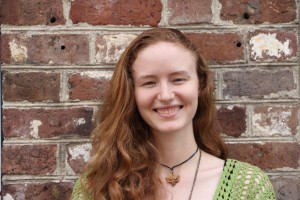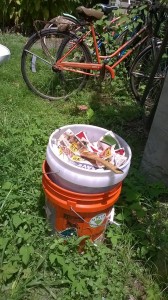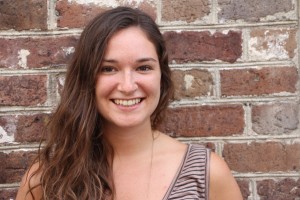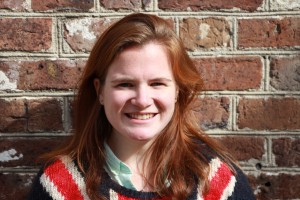Community Supported Agriculture

Everyone knows how notoriously bad for the environment packaging plastic is. In many places the plastic bags we use to transport goods cannot be recycled and even impede the process by getting caught in the machinery that separates solid recyclables. Every time we consume a candy bar, bag of rice, or any other item that is packaged in plastic, we support the processes that resulted in that packaging’s creation and will also end up supporting the ones responsible for its disposal.
A few years ago I decided that I did not want to contribute to the mass manufacture of any plastic packaging or the immense pollution and environmental destruction that inevitably results from its disposal, so I set out to find another method of purchasing items that would allow me to sleep at night without having to think about what I just contributed to.
As a vegan a significant portion of my diet is comprised of unpackaged produce from The Veggie Bin and Farmer’s Market, but there are items that are typically wrapped in packaging that I consume on a regular basis. These include: beans (of which there are 12 kinds I consume regularly), lentils, grains (quinoa, amaranth, rice, and so forth), baking supplies such as flour and sugar, teas, seeds, granolas, specialty items such as chia seeds, nuts (my favorite), etc. The amount of plastic needed to buy all of these items in a traditional supermarket is JARring to say the least.
One day I discovered that all of these items could be bought in bulk from stores such as Whole Foods, Earth Fare, and even the Veggie Bin now! Unfortunately all of the bulk sections I’ve been to have plastic bags to put items in, so I still wasn’t getting away from the packaging! Enough was enough, so I turned and reached for the Jars!
Wide-mouth Bell mason jars to be exact! Over the years I have accumulated a stockpile of somewhere around 50-60 jars. About once every semester I head to Whole Foods and raid their bulk section for all of the items I mentioned above.
The process is simple: bring jars to store, weigh jar at front and write down weight, fill jars up in bulk section making sure to record the item number in each one, and then go to check-out and have them deduct the weight of the jar with each item. At the end you will have tons of food and will have incurred ZERO waste from your purchase. Once you have eaten everything, just wash your jars and repeat; it’s that easy!
There are many benefits to shopping in this manner. There are the obvious ones such as not contributing to the manufacturing of plastics and the environmental destruction they cause, but there are also the not so obvious ones. For instance, using mason jars is immensely satisfying! Aside from that which comes from curbing your impact on the environment, there is also a strong social gratification. No matter where you shop, if you walk in with 50 mason jars you will instantly become a rock star! Every single time I have been to Whole Foods I have been met with a sense of admiration. People say things like, “Oh, that is a really good idea!” or “That is definitely something I should try sometime!” The majority of people don’t realize the effect their consumption has, so it always feels good to introduce them to alternative methods that are less damaging.
I have talked before about how important spreading ideas and awareness is to sustainability. If you find some way to live more sustainably let others know about it! My mason jars are one way that I help to raise awareness about the consequences of plastic consumption and how I avoid it. It’s a matter of reduction, the first of the famous three R’s that is, unfortunately, often the most overlooked. There are ways to reduce your impact in every part of your life, a shining example of which is the Uterine Linings Playbook blog post (which I can’t praise enough) that preceded this one. It’s the little changes, like using mason jars instead of bags, that add up to have an appreciable effect in the long term.
–William Hester, Webpage Designer at the Office of Sustainability

Warning: This blog contains some hard truths. If you were unaware before, women have uteruses. Uteruses bleed once a month. Women choose to use tampons, pads, or be like that kick-ass girl who ran a marathon WHILE ON HER PERIOD WITHOUT ANYTHING.
A Menstrual What?
Menstrual cup. Yup, it’s exactly what you think it is; a cup women can insert to hold their menses. And yes, we are really talking about this. Just as one would use a tampon or a pad to absorb the monthly flow, the menstrual cup holds the discharge until you remove and empty the cup. When I finally decided to try the cup, I one hundred and ten percent believed that the cup would not work. I’m all about that zero waste life, but experimenting with my time of the month is a no go. I never thought I would actually prefer the menstrual cup to a tampon or pad. I never thought I would be helping my roommate decide which brand to buy. I definitely never thought I would publically announce via blog my experiences, but here I am. My mom must be so proud.
I definitely am not the menstrual master or adventurous by any means. I refused to use tampons until senior year of high school. But I am stubborn, so when my roommates bet I couldn’t do it, I found myself purchasing a menstrual cup from Amazon. I had plenty of reservations and questions.
Does one size fit all? Yes and no. Think of it as buying one super tampon that you reuse. You don’t buy custom tampons. The only sizes you need to worry about is 1 or 2. Did you have a baby? Use a 2. Are you still being pestered by your mother about having kids? Use a 1. You are not buying a cup for the amount of flow. The menstrual cup companies made these sizes assuming the worst. So you’re always covered.
Yeah, but I’m special. Nope. A common myth people believe is that vagina sizes vary significantly, but, as most myths, that would be false. The only time anything changes is when you have a baby, and for those people there is a size 2.
How do you clean it? This was my concern: germs, infections, and other things ain’t nobody got time for. The cup is completely sanitary. Before using your new cup, wash the cup with soap and water. Then, you place it in boiling water for 5 minutes. Every time you remove the cup, rinse the cup in water. After each menstrual cycle, boil the menstrual cup for 5 minutes then place the cup in a cute tote for ready use the next time you have your period.
How often do you change it? Up to 10 – 12 hours. No need to worry about Toxic Shock Syndrome (something I have an irrational fear of) because the menstrual cup is made from safe medical plastic. The best part is, after you empty and rinse the cup, you put it back! Wake up, clean menstrual cup, reinsert menstrual cup, go. Clean menstrual cup, reinsert menstrual cup, sleep. Eat. Sleep. Menstrual Cup. Here are examples of when you can use the menstrual cup:
Could you leak? Nope. Sometimes you’ll need to change it out more frequently when you have a heavier flow, JUST AS YOU WOULD WITH A TAMPON OR PAD. Except for tossing after use, you clean and reuse.
I have a heavy flow. I feel you. I tend to have a heavier flow, and by heavier I mean my uterus would save more lives than the Red Cross. Why I love this cup so much is because it seals, which means no leaks. This cup actually works better than a tampon or pad. I WORE WHITE PANTS WHILE ON MY PERIOD. The women in the tampon commercials got nothing on me.
Yeahhh…no. That’s way out of my budget.
I thought this blog was supposed to be about sustainability? Right. Using the cup is sustainable. Your used feminine care products do not just disappear. They spend the next hundreds of years just chilling at a landfill just like the rest of your trash. Now, think about all the times you have your period. Think of all those pads piling up. What only was a part of your life for 6 hours is now part of the landfill for hundreds of years. One pad isn’t so bad, so you don’t feel guilty tossing one. It’s easy to forget about your trash once you toss it, but think of all the pads that you will toss in your lifetime, in your mother’s lifetime, in your roommate’s lifetime, in your children’s lifetime. Think of that super pack of tampons you just bought; that’s future landfill. Think of all the super pack of tampons that all the people at the College of Charleston bought. Landfill. Think of all the …. you get the point. (Learn more about sustainable cycles here)
I’ll admit, using a menstrual cup is a small step for all the world needs to do to be sustainable. You’re probably thinking what’s the point, but you’re thinking of this all the wrong way. You’re over achieving. Think about the impact in your life, the amount of waste YOU will reduce. As a wise wrinkly man once said, “be the change you want to see in your local landfill.” Or something like that. I’m a science major, not a historian.
This post was written by an intern at the Office of Sustainability
Once upon a time, a red-head was biking home in the Charleston heat. She noticed a car slowing down beside her and thought, What is this crazy driver doing? When she did not respond, the driver whistled and yelled, “Hey — You hot?” She ignored him, thinking he was a random stranger hitting on her, only to realize that this “crazy driver” was her friend waving to her as he drove away. Oops!
Yelling my name would have helped… Oh well.
This funny story highlights an interesting way that people interact. It’s awkward for a person in a car to interact with a biker or a pedestrian or even another person in a car. When drivers do interact with anyone outside their car it’s either honking at someone or slowing down to yell out the window — usually inconvenient to others on the road. Drivers seem to be in their own little bubble while bikers and walkers have more freedom for face-to-face interaction. But even pedestrians ignore each other.
How do we get out of this mindset of “I’m-in-a-bubble-going-quickly-from-point-A-to-point-B-so-nobody-bother-me”?
I would argue for a less stressful and more efficient transportation system that includes all modes of transportation. Maybe then the mindset of commuters can be more friendly and open.
-Eileen Szwast

When I was little, I always liked riding bikes, but it was only for recreation. The first time I used a bike as a form of transportation was for summer art camp (REDUX) in high school. I didn’t have my driver’s license yet and I wanted to save my mom a trip. So, unknowingly, I became one of those “bikers.” A biker who has to deal with rude cars (unnecessary yelling and honking and cutting in front), rain, scorching heat, freezing cold, blinding dust, and wind that tries to push you backwards. And there’s also those days of amazingly beautiful weather where you’re so glad you’re not stuck in a car.
I rode my bike from West Ashley, over the Ashley River Bridge, and through the busy streets to the REDUX art camp in downtown Charleston. At first I was very timid, always sticking to the sidewalks and fearful of the cars whizzing past.
It wasn’t until my Freshman year at the College of Charleston, where I learned that bikes are supposed to be ON the road following the rules of the road, that I became a more “daring” biker. And by “daring” I mean racing cars to stop signs and shaking my head at rude drivers. Sometimes I imagine myself throwing rotten tomatoes at them. (If anyone wants to get my a fog horn, that would be wonderful, because bike bells don’t work on cars.)
Being a biker wasn’t a decision for the environment or to try and save the world, but one of convenience. Transportation that takes me from the doorstep of point A to the doorstep of point B and includes FREE parking and also keeps me in shape. The only drawback is the dangerous conditions I have to deal with on the road. Roads were created for all people, not just cars. Here’s to making the roads safer for all forms of transportation!
-Eileen Szwast

What initially drew me to the office was the chance to learn more about sustainable practices as opposed to just being aware of them. I came to the conclusion that only good can come out of an environment filled with smart individuals contributing to collective efforts. So far my favorite thing I’ve learned is how to compost. And around the same time as learning about it, I started up my own bucket of vermicompost.

Pretty much just a bucket filled with some soil or substrate, and a bunch of worms.
After a week or two, the worms had already started to break down the majority of food scraps and paper wastes I had put in the bucket. The process has only sped up from there.
Pretty soon I’ll have my own stash of compost! I plan to use it in my future gardening endeavors.
In regards to the connections I’ve made through the office, I’ve become somewhat employed at Blue Pearl Farms. It’s a blueberry farm where the only rules are to fiinish the task at hand and to eat the biggest blueberries. It’s some hard work but at the same time I’d rather be working out in a field as opposed to working in a cubicle for the rest of my days.
-Tanner Wharton
Before I became acclimated with sustainability, I thought it was analogous with environmentalism. My definition of the term was based on maintaining Earth’s physical resources and protecting its biological functions. However, since working at the Office, I’ve realized that sustainability is so much more. While addressing environmental issues is essential to living more sustainably, we must also consider the fact that these issues would not exist if our values lied elsewhere. In my eyes, sustainability seeks to reform and protect people, and favors a society driven by feelings and ideas, rather than things. It works towards achieving ideal concepts such as individual meaning and life purpose, self-fulfillment and sufficiency, the development of meaningful relationships and a sense of community.
I feel extremely fortunate to have been exposed to these things through the garden apprenticeship program here at the Office. Gardening embodies two seemingly opposite but both integral parts of sustainability: self-sufficiency (me) and community (we). Being able to provide for yourself by growing your own food is unbelievably empowering. It allows us to be independent of industrial agriculture and get reconnected with what we consume. While gardening can be personally fulfilling, it also provides a sense of belonging and interdependency among people. Instead of isolation, there’s the accumulated knowledge of fellow gardeners to draw on. The entire process is a teaching-learning experience where we grow with and from each other. It’s about teaching people to fish so that we can do so alongside each other, instead of just doing the fishing ourselves. Beyond that, the apprenticeship program has allowed me to form relationships that would have never spawned otherwise, and for that I am so grateful.
Gardening makes you feel grounded and connected to your food, as well as to the people around you. The process can be therapeutic and tranquil, and the results oh-so-satisfying. When you dissect the word agriculture, you find the prefix agri- (meaning field or related to the land) and the word culture (a way of life of a group of people and their behaviors, beliefs, and values). Agriculture literally means getting in touch with the Earth as well humanity, forming a holistic connectivity with everything around you.
The garden apprenticeship program has made me feel as though I am part of something larger than myself – a community. This natural result of gardening is also one of the ultimate goals of sustainability. Barrett Brown of the Integral Institute for Sustainability offers a definition that embodies these notions of self-sufficiency and community: “an alignment of the different levels of our individual and collective consciousness so that we can create, maintain, and healthily evolve.” Our path to a sustainable world will be accomplished by participating in actions that contribute towards self-reliance, a shared purpose, and the greater good. This is why I firmly believe that to plant a garden is to believe in tomorrow.
-Katie Kerbel

The Root of the Problem
Roots. The networks that make up various types of plant life, drawing in water as well as nutrients and leaving complex compounds behind. These intricate systems have been the foundation of every civilization known to man, yet our generation has voluntarily chopped off it’s green thumb in favor of whatever is most convenient. Convenience is rarely a good measure of worth, and it is unsurprising that this mind set has led to mass produced nutrient deprived vegetation and soil, as well as very little awareness of how to fix the problems that we have created. Learning the skill of planting has never been more relevant, or more inaccessible. How do you bring gardening to people who don’t realize why it is important, or even if they did, don’t have an area to grow one? To build a garden, all that is needed is a little bit of healthy soil, a little bit of space, and only a few pots and planters to start with. In many cases, an urban garden can be found locally. Such is the case here in Charleston SC, where there is an urban garden at MUSC. The most important thing of course, is to learn how to keep plants healthy in whatever environment you may find yourself… even if that’s a sweltering hot and humid 102 degree Charleston during the summer!
During week 1 of the Garden apprenticeship it became clear to me that I know much less than I realized. We spent two full days talking and learning about compost. A complex subject that we barely scratched the surface of, including how to use worms to do it for you. We also learned the science that is sheet mulching.
Week 2 we all met with Carmen at the aforementioned MUSC urban garden to lend a hand, but also to learn about the role that pH plays in soil composition and plant development. Carmen knows a ridiculous amount of stuff about plants, so…
Week 3 we met with Carmen again to get more hands on experience, and to talk about planting schedules as well as growing plants from cuttings such as those that are definitely not from your neighbor’s lemon tree.
Week 4 we focused on what is now one of my favorite topics, bees! We visited Blue Pearl Farms, a small farm on the outskirts of Mt. Pleasant that has managed to grow blueberries naturally and profitably. After careful instructions we were allowed to pick berries and taste test a few. After listening to the owners of Blue Pearl talk about their experience with their farm, we had an opportunity to wear some HAZMAT worthy gear and get up close and personal with the busy bees themselves, who are responsible for much of Blue Pearl’s success.

It wasn’t until week 5 that we covered planting seed with Lexa and Katie from the grounds department, and using compost that is made on site at the College of Charleston, we planted a handful of plants to be re planted as tiny sprouts in roughly a month’s time. Until then they are being kept in the greenhouse behind grounds.
Because many plants are grow more efficiently in communities, or guilds, this week will be focused on learning about companion planting among other things.
When I applied for an internship at the Office of Sustainability, with only a vague idea of what sustainability meant or how urban gardening could make an impact on it, I thought I was making a decision to be more conscious of my effect on the environment. In reality however, I am learning how little I know about the pressing problem of food production in the United States, of chemicals and GMOs, and many other very real threats being posed to our society, by our society. Returning to our roots, our networks and communities, to find support and knowledge is the best chance any of us have of making any permanent change to these harrowing conditions. Like a plant, it is from our roots that awareness and the impending reform necessary to continue our way of life will grow.
-Savannah Langley
College of Charleston campus has lots of options of where you can park your bike. Guess how many bike racks we have on Main Campus, Harbor Walk, and the Avery Center? Over 200!
Yet some days it feels like you can never find a decent place to park because the bike racks are filled or a balky beach cruiser fell over taking up 5 spots.

I am looking at you, Bell South……….
Sometimes racks are being prevented from doing there duty.

I don’t know…..
Is that an iced coffee?

Caution: bike rack can’t rack
We are here to help you out! We have found all those bike racks that are hidden gems which people don’t realize are there.
Check out this sweet rack behind the New Science Building
If it is raining, keep your bike covered behind Berry Residence Hall.
You thought this was some weird art? No! This is the bike racks behind the Education Center!
Instead of following the crowd, park behind Robert Scotts Smalls instead of on Cougar Mall
Might not be the best view at Harbor Walk but there are bike racks in the loading dock area
Where ever you end up parking remember to make sure your bike is secure. Bike on my friends bike on.
-Eliza Bower

There are some things that you can’t close your eyes to once you’ve seen them. The worldwide waste problem that humanity is facing has to be addressed. The problem has been burned and buried, but the giant trash elephant in the room has to be addressed. According to the EPA, in 2013, the United States alone produced over 254 million tons of waste. Of that, 34.3% was recycled or composted. Over the last 25 years, recycling has become more commonplace and the recycling rate has more than doubled from 16% in 1990. Through source reduction, composting, and recycling, the United States has made great strides to reduce the waste produced and sent to the landfill. The goal for zero waste is to have 90% recovery of the resources that would otherwise be sent to the landfill. We are a long way from the 90% goal, but it is a goal that we can all strive for. Unfortunately, these numbers don’t account for industrial waste, only municipal waste, which “consists of everyday items we use and then throw away” (EPA). The EPA states the industrial waste is approximately 7.6 billion tons per year.
The industrial waste is linked to our municipal waste as the hidden costs behind our consumption. In order to reduce both municipal and industrial waste, we have to be active in our lives and communities. Civic engagement and sustainable living are closely tied together. In order to truly be sustainable, we have to support each other in the community. One way of supporting each other is by sharing knowledge and skills that can help create a ripple effect of lasting change and mindset altering. Reducing consumption, mindful purchasing, recycling, and composting are all great things that we can do to start a change. If we strive towards these practices and effectively communicate the urgency of the waste problem, it will hopefully be infectious to the people around us and spread from the ground up to the top.
Buy products made locally, or even learn how to make replacements of some of these things yourself. When purchasing commercially produced products, stop and ask yourself if you really need it. Chances are you won’t need as much as you think. Placing a compost and a recycling bin right next to your trash is extremely easy and takes a short time to get used to. Encourage and educate the people in your sphere of influence about the small changes that can be made in order to make a large change overall.
It’s not a big commitment and it’s only made through small changes. When we add a few slight inconveniences (that will quickly become habitual) to our daily routine, we can start to make a change that will become normal for generations to come. I dream that future generations will have the default mindset of “how can this be reused or recycled” instead of the current “but the dumpster is so far away” mindset. It will be a long process, but change is already happening. We can only do it together and I hope we can all agree that it’s time to face the waste.
-Arthur Phillips
